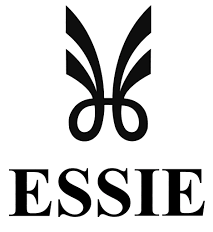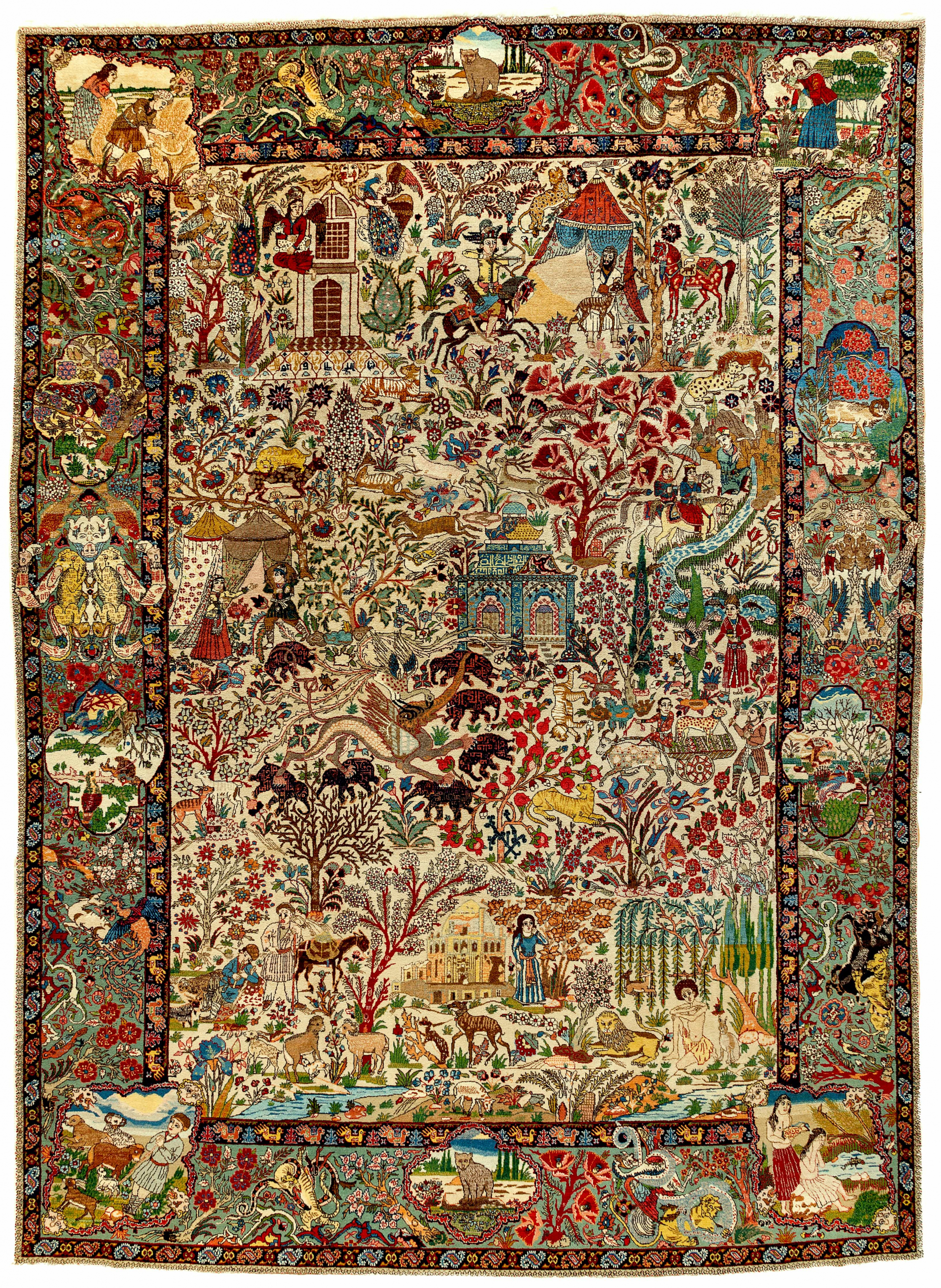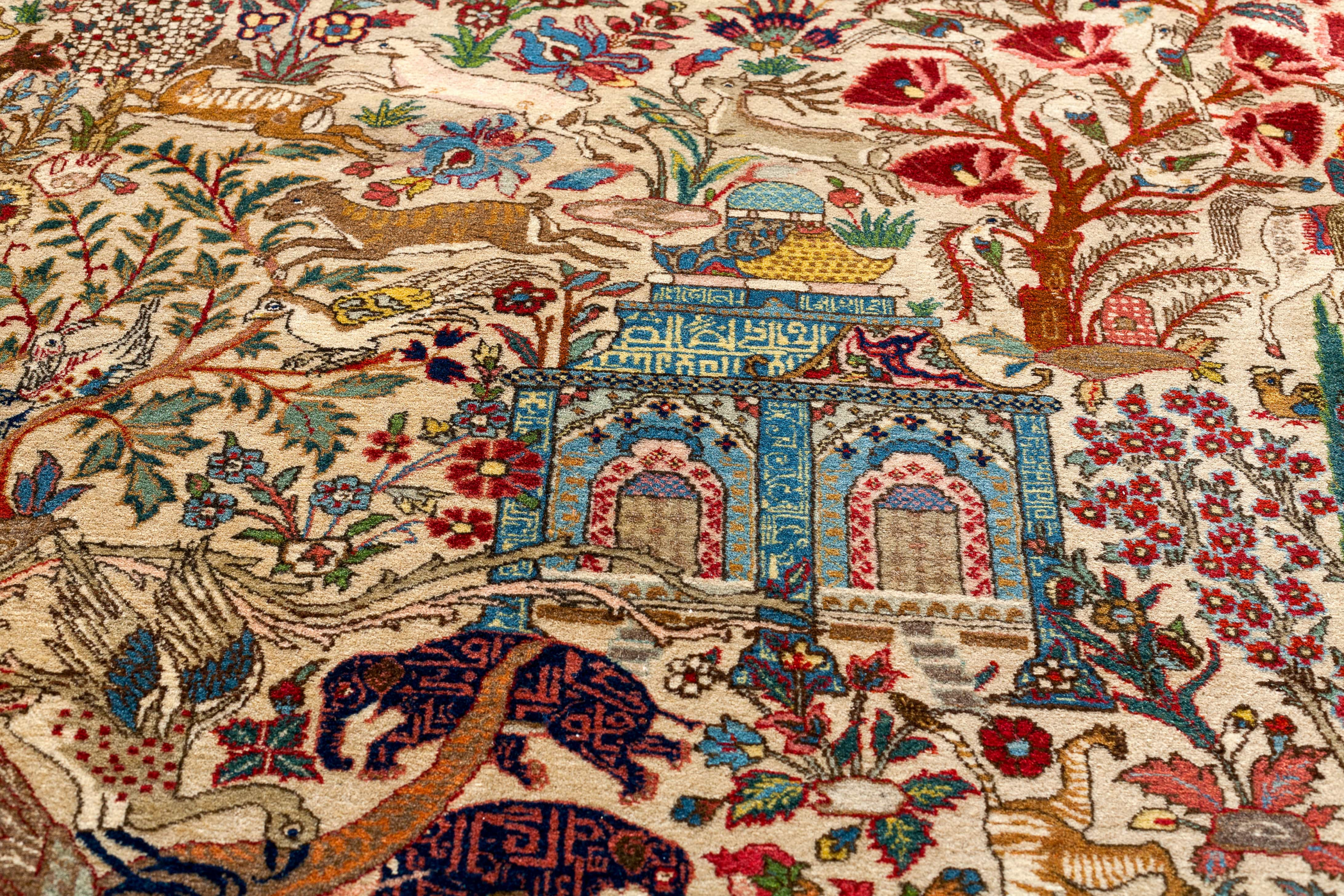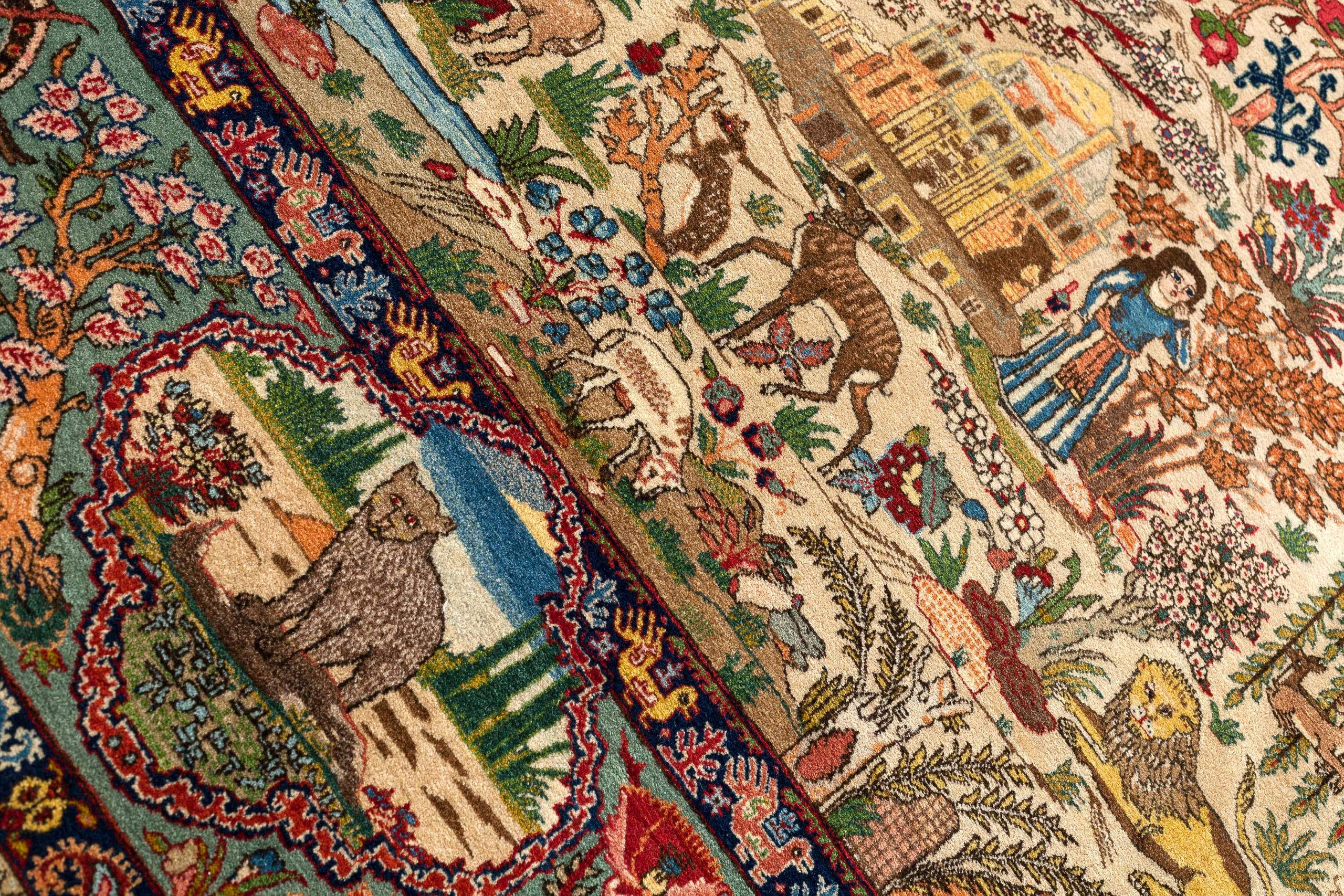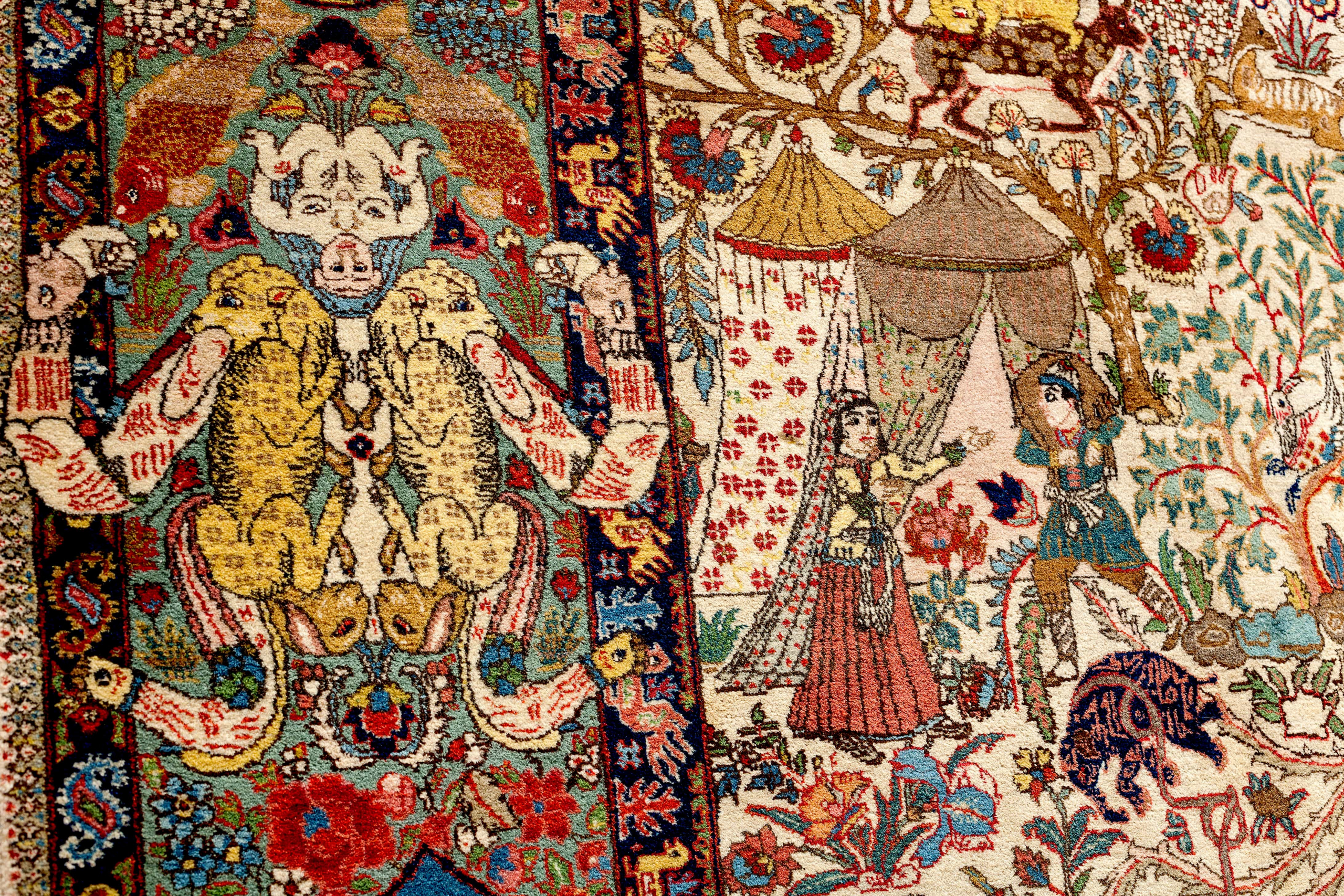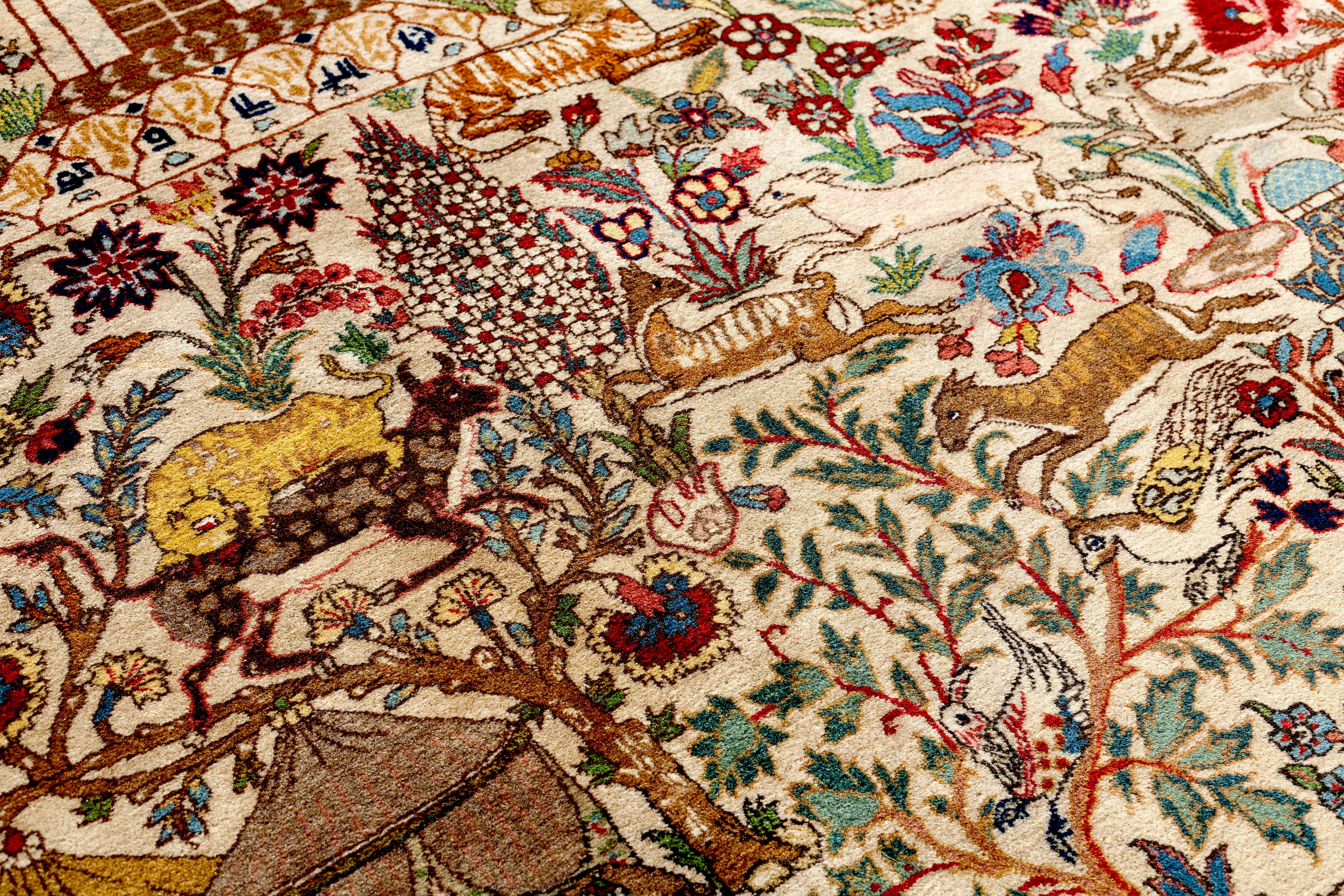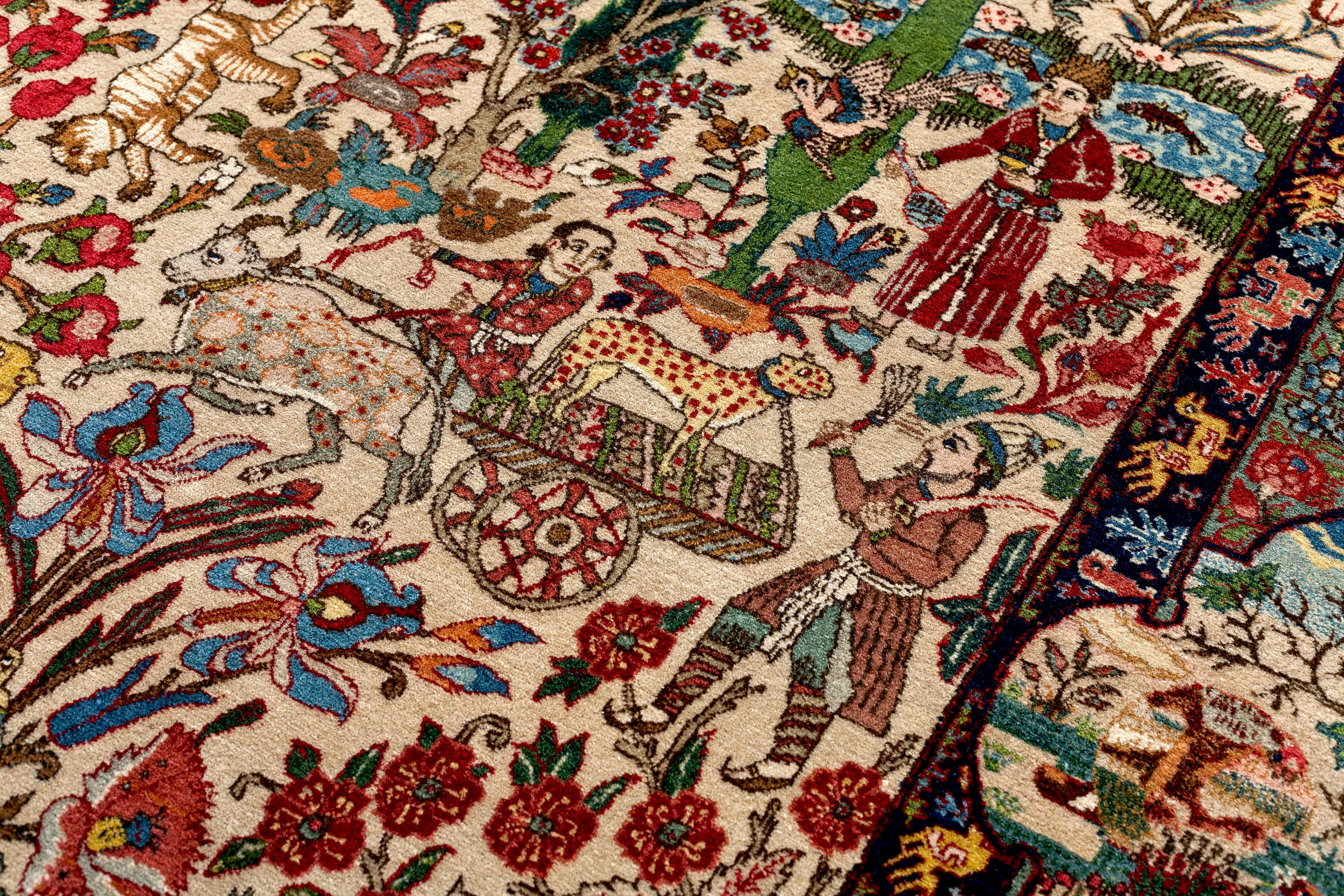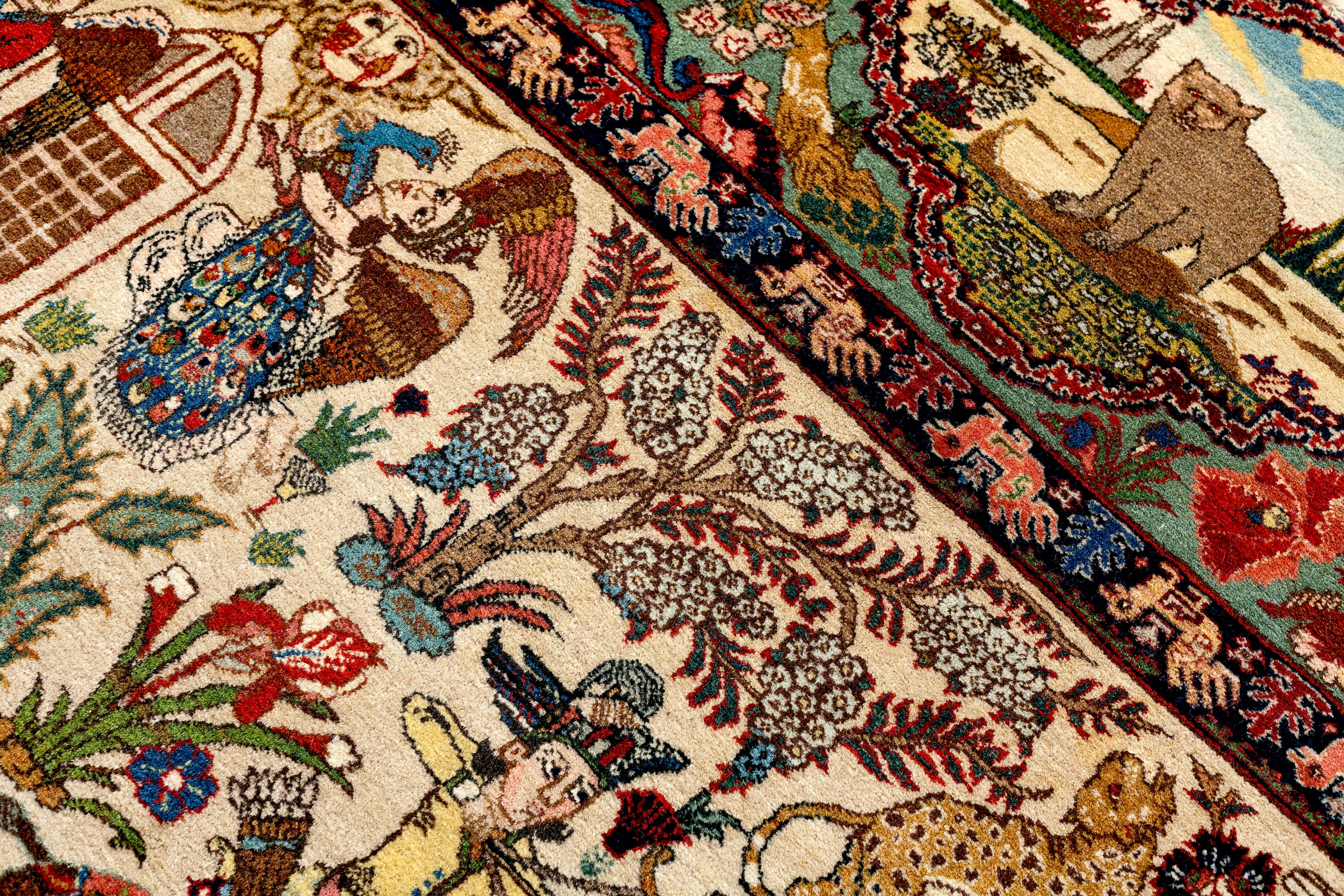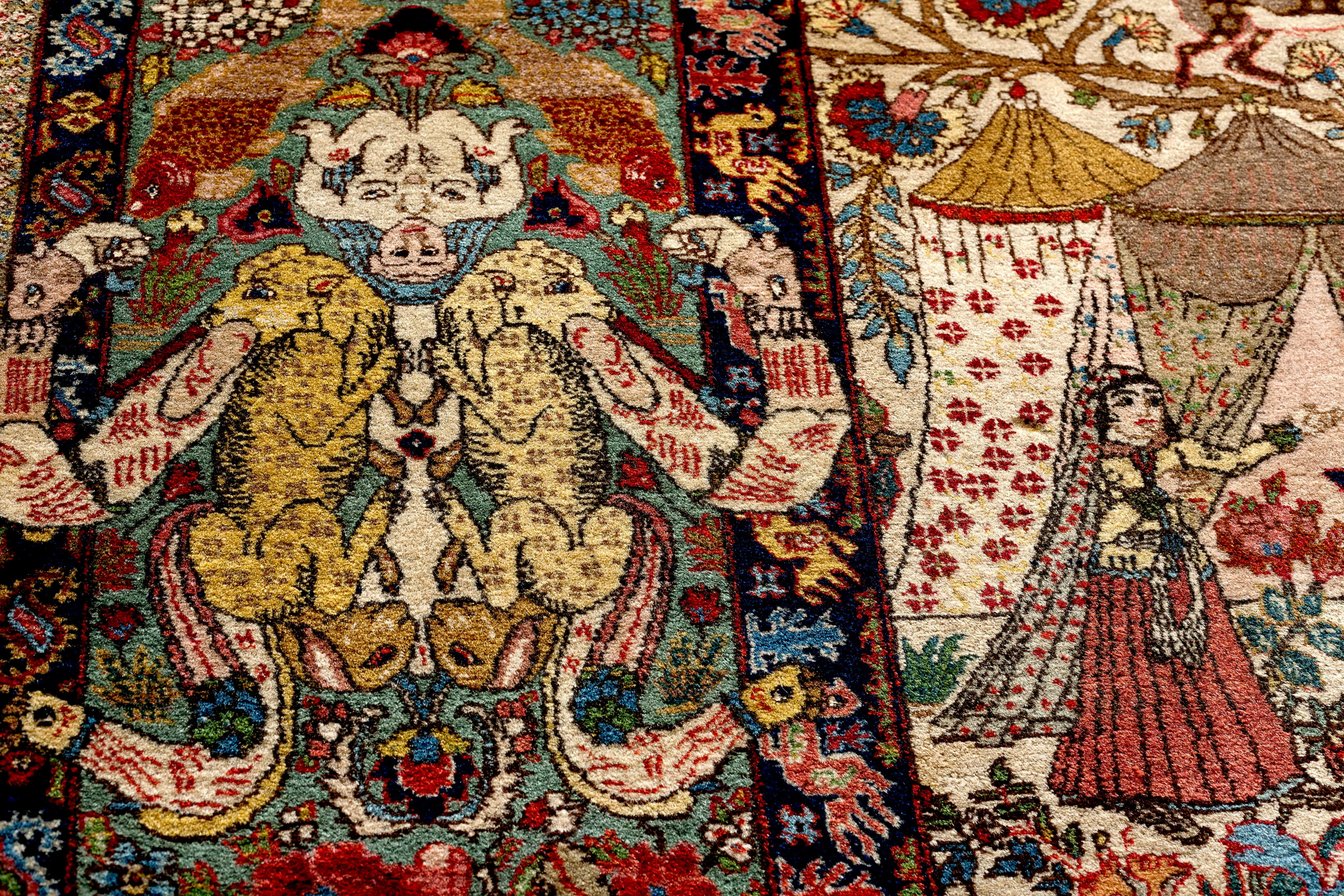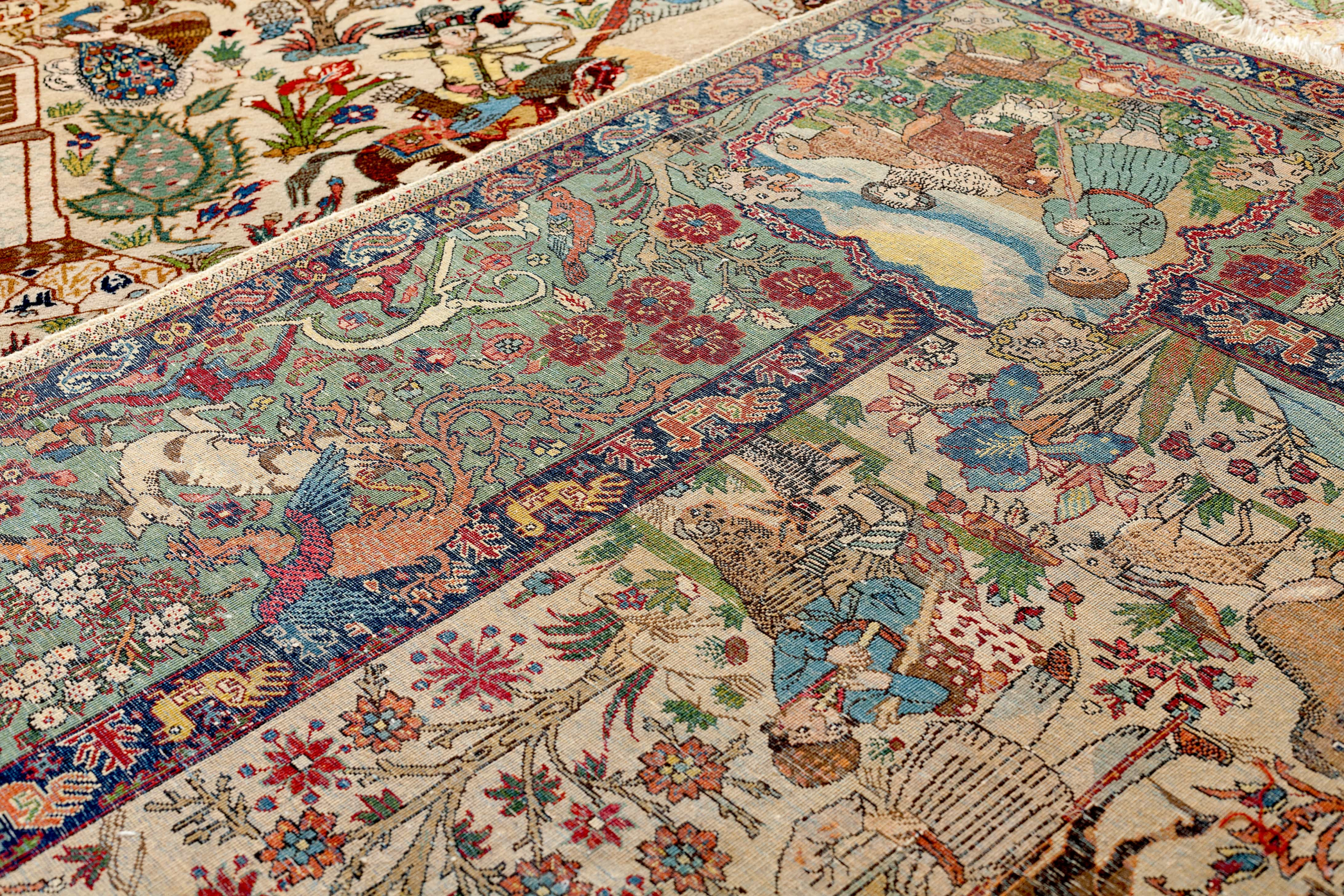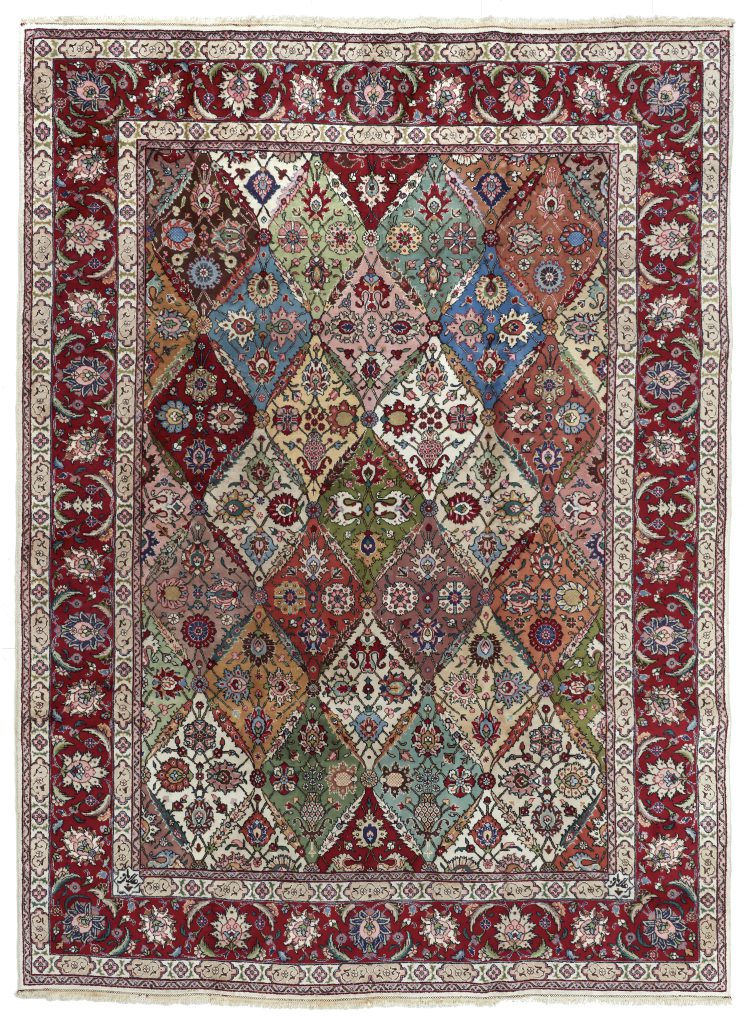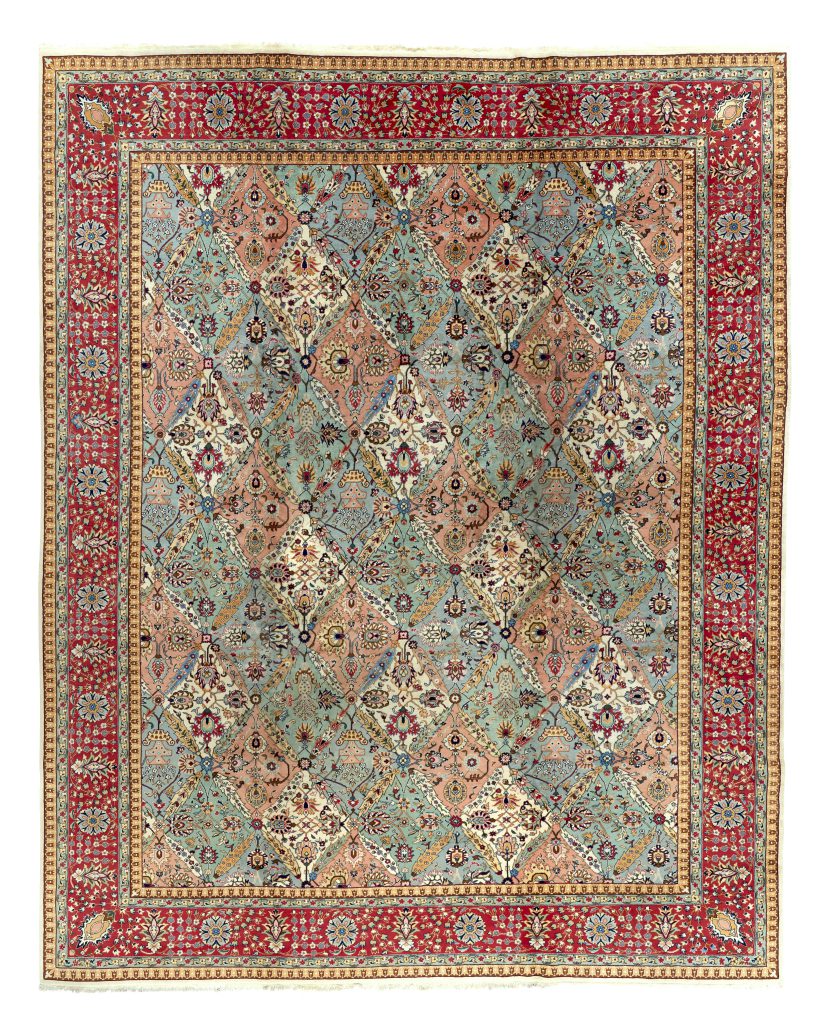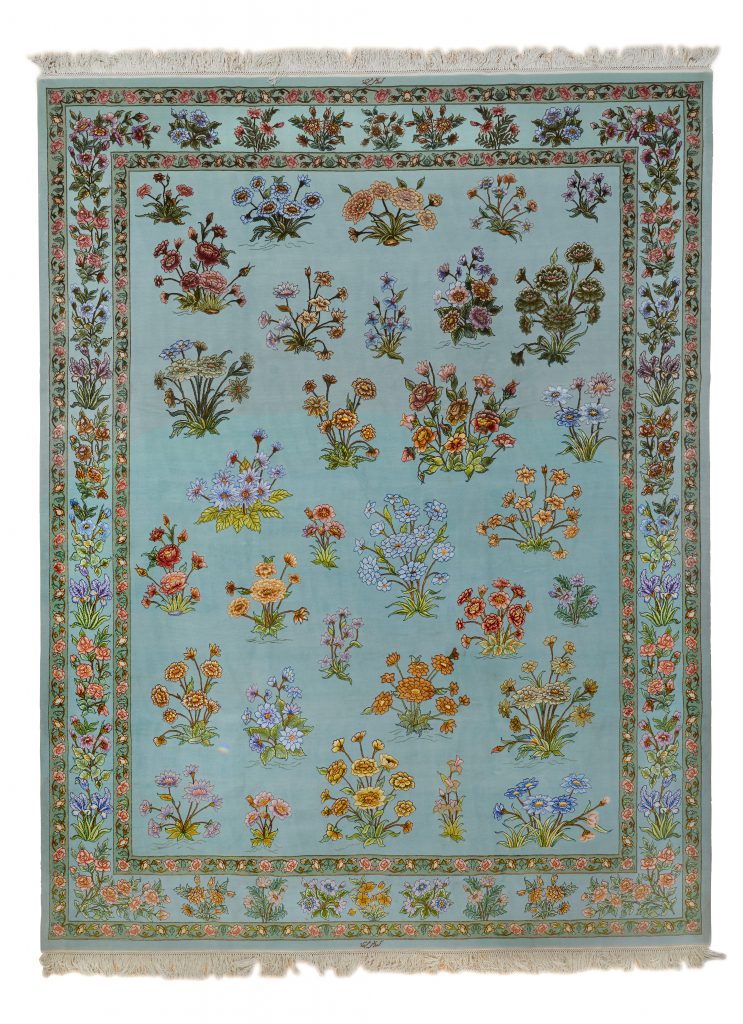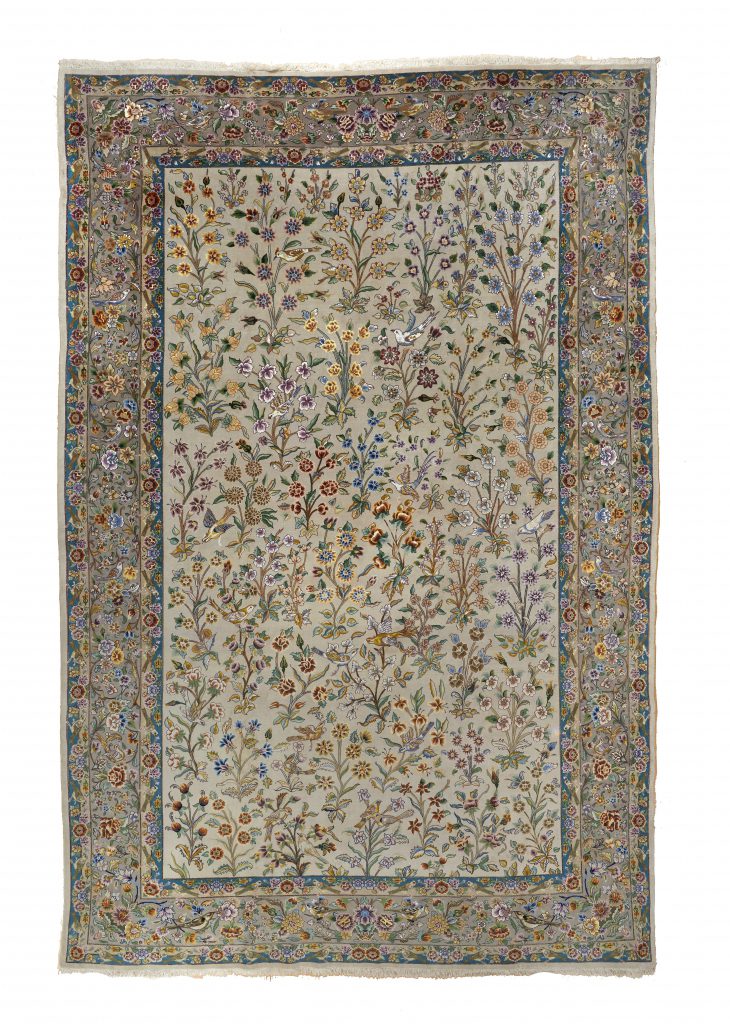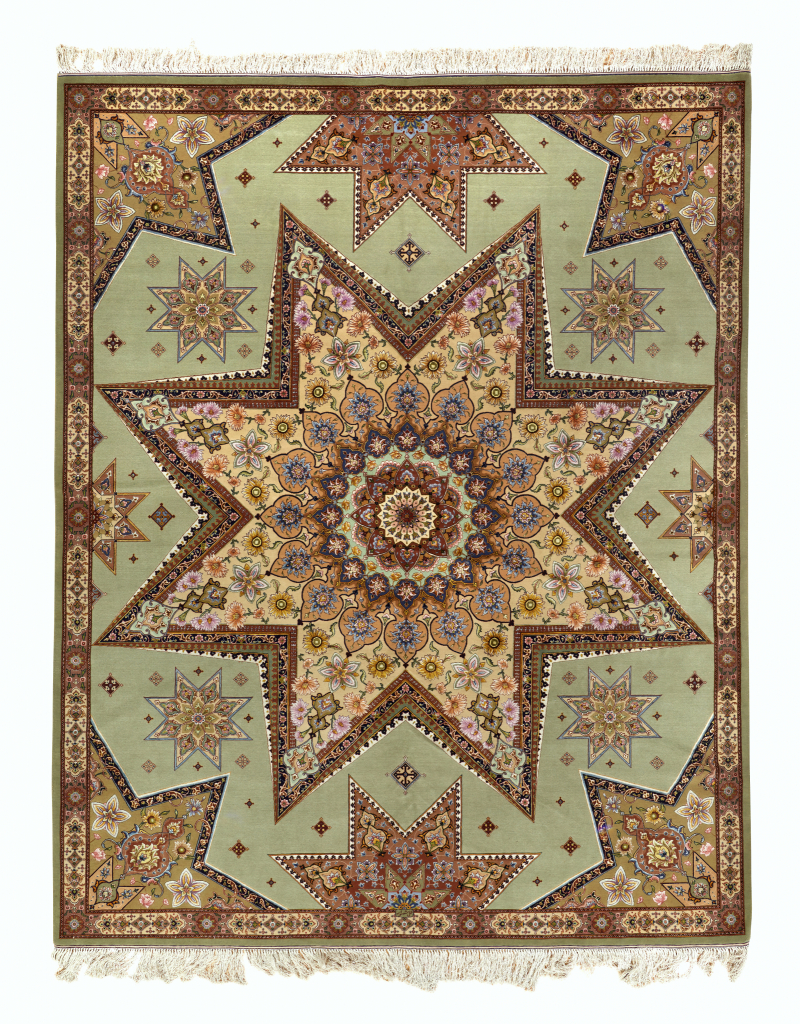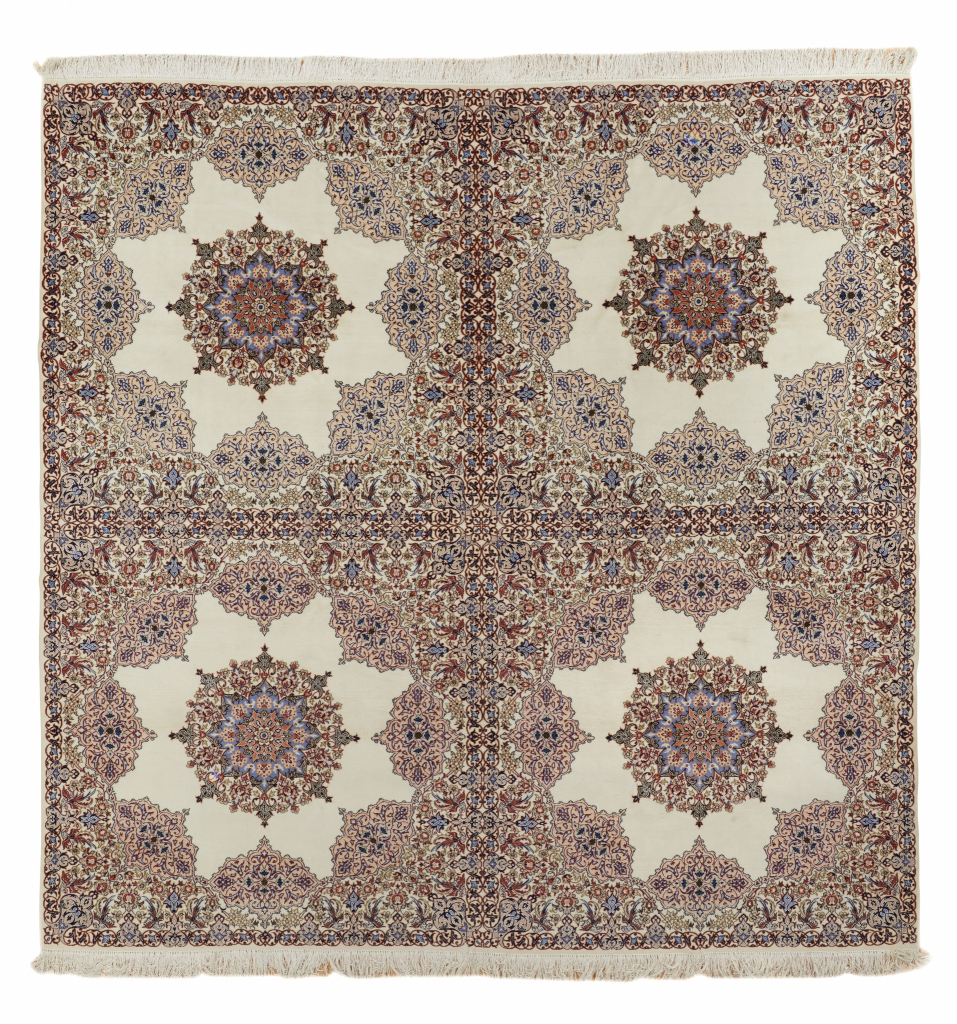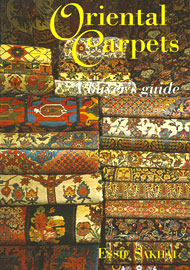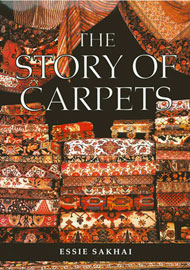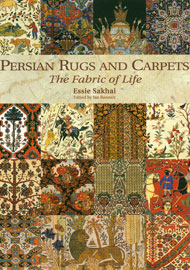Magnificent Persian Tabriz Pictorial Carpet
Rug #2569Persian Tabriz Carpet – Fine Wool
Persian Tabriz pictorial carpet handwoven in Iran from fine wool.
A Magnificent Fine and Rare Persian Tabriz Pictorial Carpet, North West Persia, Wool on Cotton Foundation
Early 20th Century
The ivory field with a pictorial landscape scene depicting scenes from Persian verse, with human figures, naturalistic and mythical beasts and buildings amongst ascending flowering trees, above a river landscape, within a complex blue border enclosing blossoming tree, flowering plant and animal border
Since the 16th century the city of Tabriz has been an important historical centre for the production of outstanding and significant decorative handmade Persian carpets.
Historically Tabriz, primarily due to Geographical location has always attracted a multi-cultural populace, which over time has resulted in a huge and varied repertoire of design styles of ‘medallion’ and overall repeat patterns, pictorial rugs including hunting scenes influenced by Persian history, verse and mythology. The weavers of Tabriz are well known for their skill and ability to adapt to evolving demands. From the ‘Golden Age’ of carpet art creativity of the 17th Century, Tabriz has maintained continuity in pursuit of excellence and due to increase of interest and demand for ‘all things Eastern’ in Western markets from the late 19th century the talented Tabriz weavers responded accordingly. The considerable increase in demand from the late 19th Century onwards is often referred to as the ‘Revival’, and by the time of the Pahlavi dynasty, established in 1925, the ‘Revival’ was well under way. Persian Tabriz carpets made at this time and moving forward to the present day display designs based on 17th century ‘Safavid’ carpet designs and also ingenious new styles of design based on wider influences and the desire to be adventurist.
This exceptionally fine Persian Tabriz carpet is a magnificent example of Persian ‘revivalist’ weaving, presenting scenes from Persian verse and stories. The ascending depiction includes a huge variety of animals, including wild beasts, domestic animals and mythical creatures, including a writhing dragon with subdued elephants and Simurgh bird. These are all presented in varying orientations as subject matter with human figures all presented in wooded scenes and buildings. One of the scenes depicted in this Persian Tabriz carpet is from the love story of Layla and Majnun by the poet Nizami written around 1188. (See foot note). Majnun is seen kneeling close to a lake, supported by a lion below a willow tree. The female figure in front of the large building to the left above the kneeling Majnun may well be the lamenting Layla. Among the other scenes in this Persian Tabriz carpet is the depiction of a mythical dragon capturing elephants. In turn the dragon is under attack from the Persian mythical bird, the Simurgh, often related to the Phoenix, no doubt symbolic of good versus evil. This pictorial element is prominently placed to the right and centre of the composition. This is rare cameo and would appear to stem from ancient Indian legend, for details, see footnote. Even more curious and rare is the addition of the Persian Simurgh, included in Indian legend. The various ascending trees, symbolic of longevity are typically seen in classical 17th century Persian carpets, and are seen in this revivalist Persian Tabriz carpet, which include weeping willow trees ( bid majnun), plane trees and cypress trees and curiously and rarely seen pomegranate tree given prominence in the centre of the carpet. The pomegranate is significant in Persian Zoroastrian history and is a symbol of marriage and fertility.
The colours are from an extensive Persian Tabriz carpet palette and have been selected and juxtaposed to magnificent effect to create the most powerful image of storytelling subject matter. The border treatment in this Persian Tabriz carpet is no less rare and unusual. The theme of longevity continues by the inclusion of the ascending blossoming trees, and included are the combative beasts symbolic of good versus evil, though the addition of ogival medallions, top and bottom end borders presents a brown bear in its own landscape scene. This is an extremely rare pictorial addition. The colours used in the border and the larger scale of the pattern drawing contrasts magnificently with the finer drawing of the field drawing, enhancing the visual impact of the overall composition. The individuality of this Persian Tabriz carpet continues; the inner blue guard border displays totemic, geometrically drawn plants and birds, in total contrast to the drawing style of any of the other flora and fauna forms. These stylised forms are clearly from tribal tradition, as opposed to urban tradition, and more precisely are reminiscent of Caucasian tribal flora and fauna forms. It is not unusual to see such tribal elements in Persian Tabriz carpet compositions but it is unusual to see these two styles combined in this way in the same carpet design.
This magnificent Persian Tabriz carpet is an outstanding example from the ‘Pictorial carpet’ genre, combining classical 17th century design subject matter and classical styles of pattern drawing combined with an original ‘revivalist’ approach to representation. The subject matter clearly displays traditional themes of good versus evil, longevity and love and marriage. The whole composition is a triumph of ‘vision’ in presenting stories from differing cultures and history in a clear readable fashion. This Persian Tabriz carpet has been created by exceptionally skilled weavers, fully conversant with traditional subject matter and displaying the desire to be original and adventurist.
For further information please contact us and our team will be pleased to assist you. All pieces in the collection are under the auspices of Essie Sakhai, one of the world’s foremost experts and collectors of fine handmade Persian rugs and carpets.

Delivery
Delivery
Enjoy Complimentary Express Delivery at Checkout
Free express next-day delivery on all UK orders.
Free express delivery on all international orders above £2,000.
Estimated Delivery Times
Please allow between 1-3 days for UK, Europe and United States destinations and 5-7 days for Far East, South America, Middle East destinations.
Please note that orders placed after 12pm (UK time), on the weekend, or during holidays will be processed on the following business day. You will be provided with a shipping tracking number once your order has been shipped.
Collection from our Mayfair London showrooms
In-store collection will be ready within 1 business day. To collect in-store you will be required to show confirmation e-mail, official photo ID (passport or driving license) and the payment card used for the order. If someone else is collecting on your behalf, please make sure they bring a letter of authorisation that permits this person to collect on your behalf, official photo ID of the purchaser and of the person collecting and confirmation e-mail.

Exchanges
Exchanges
Essie Carpets offers clients a lifetime exchange service on any items purchased from us should you wish to change your carpets at any time in the future, subject to the item being in good condition; this can be particularly useful when redecorating your home, or when an upgrade in type or quality is desired.

Payment
Payment
Payments are accepted via credit card or debit card with a valid billing and shipping address*. Accepted credit cards are Visa, American Express, and Mastercard. When placing an order, your billing address must correspond to the address of your credit card, or we will not be able to process your order.
Bank Transfers are also accepted; in order to pay by Bank Transfer, please contact our Client Services via telephone at +44 20 7493 7766 or e-mail at sales@essiecarpets.com.
All transactions are secured. The Essie Carpets website is provided with an SSL encryption system to protect personal and payment data.
Similar Carpets
-
 Fine Persian Tabriz 'Vase Design' Carpet - Signed 340 x 256 cm
Fine Persian Tabriz 'Vase Design' Carpet - Signed 340 x 256 cmRug #7151 Fine Persian Tabriz 'Vase Design' Carpet - Signed POA
Fine Persian Tabriz ‘Vase Design’ Carpet – Signed
-
 Fine Persian Tabriz Carpet 442 x 352 cm
Fine Persian Tabriz Carpet 442 x 352 cmRug #7143 Fine Persian Tabriz Carpet POA
Fine Persian Tabriz Carpet
-
 Extremely Fine Persian Tabriz Carpet - Signed 307 x 244 cm
Extremely Fine Persian Tabriz Carpet - Signed 307 x 244 cmRug #7009 Extremely Fine Persian Tabriz Carpet - Signed POA
Extremely Fine Persian Tabriz Carpet – Signed
-
 Very Fine Persian Tabriz Carpet 300 x 195 cm
Very Fine Persian Tabriz Carpet 300 x 195 cmRug #7008 Very Fine Persian Tabriz Carpet POA
Very Fine Persian Tabriz Carpet
-
 Fine Unique Tabriz Rug - Signed 250 x 197 cm
Fine Unique Tabriz Rug - Signed 250 x 197 cmRug #7006 Fine Unique Tabriz Rug - Signed POA
Fine Unique Tabriz Rug – Signed
-
 Fine Rare Persian Esfahan Rug - Square 244 x 244 cm
Fine Rare Persian Esfahan Rug - Square 244 x 244 cmRug #7004 Fine Rare Persian Esfahan Rug - Square POA
Fine Rare Persian Esfahan Rug – Square
